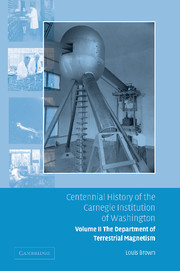Book contents
- Frontmatter
- Contents
- Foreword by Richard A. Meserve
- Preface
- 1 Establishment
- 2 Cruises and war
- 3 Expeditions
- 4 Measurements: magnetic and electric
- 5 The Fleming transition
- 6 The last cruise
- 7 The magnetic observatories and final land observations
- 8 The ionosphere
- 9 Collaboration and evaluation
- 10 The Tesla coil
- 11 The Van de Graaff accelerator
- 12 The nuclear force
- 13 Fission
- 14 Cosmic rays
- 15 The proximity fuze and the war effort
- 16 The Tuve transition
- 17 Postwar nuclear physics
- 18 The cyclotron
- 19 Biophysics
- 20 Explosion seismology
- 21 Isotope geology
- 22 Radio astronomy
- 23 Image tubes
- 24 Computers
- 25 Earthquake seismology
- 26 Strainmeters
- 27 The Bolton and Wetherill years
- 28 Astronomy
- 29 The solar system
- 30 Geochemistry
- 31 Island-arc volcanoes
- 32 Seismology revisited
- 33 Geochemistry and cosmochemistry
- 34 The Solomon transition
- 35 The support staff
- 36 Epilogue
- Notes
- Index
26 - Strainmeters
Published online by Cambridge University Press: 06 January 2010
- Frontmatter
- Contents
- Foreword by Richard A. Meserve
- Preface
- 1 Establishment
- 2 Cruises and war
- 3 Expeditions
- 4 Measurements: magnetic and electric
- 5 The Fleming transition
- 6 The last cruise
- 7 The magnetic observatories and final land observations
- 8 The ionosphere
- 9 Collaboration and evaluation
- 10 The Tesla coil
- 11 The Van de Graaff accelerator
- 12 The nuclear force
- 13 Fission
- 14 Cosmic rays
- 15 The proximity fuze and the war effort
- 16 The Tuve transition
- 17 Postwar nuclear physics
- 18 The cyclotron
- 19 Biophysics
- 20 Explosion seismology
- 21 Isotope geology
- 22 Radio astronomy
- 23 Image tubes
- 24 Computers
- 25 Earthquake seismology
- 26 Strainmeters
- 27 The Bolton and Wetherill years
- 28 Astronomy
- 29 The solar system
- 30 Geochemistry
- 31 Island-arc volcanoes
- 32 Seismology revisited
- 33 Geochemistry and cosmochemistry
- 34 The Solomon transition
- 35 The support staff
- 36 Epilogue
- Notes
- Index
Summary
In 1967 Dale W. Evertson of the Applied Physics Laboratory, University of Texas, visited Sacks to demonstrate a curious yet remarkable instrument, called a solion. It was capable of detecting the flow of extremely small ion currents in solution between two electrodes and had been developed as an acoustical detector for very low-frequency waves, the outgrowth of anti-submarine research that had found it of no use. Impressed by its sensitivity, Evertson searched for an application and constructed a seismometer with it, hence the visit. Sacks found it unimpressive as a seismometer but saw in the solion another application and initiated a field of study that was to occupy both men for the remainder of their careers.
Ever since earthquakes had been associated with faulting there had been a general belief that the key to understanding, even predicting them lay in determining the strain that built up in crustal structure. This naturally led to the invention of a variety of devices for measuring strain. These were generally based on the accurate measurement of the distance between two piers in a cave or tunnel having little temperature variation. From these efforts beginning in 1900 little of substance had come for reasons soon to be explained. Sacks saw in Evertson's device a new, and as it proved, successful approach to this old problem.
- Type
- Chapter
- Information
- Centennial History of the Carnegie Institution of Washington , pp. 195 - 202Publisher: Cambridge University PressPrint publication year: 2005



